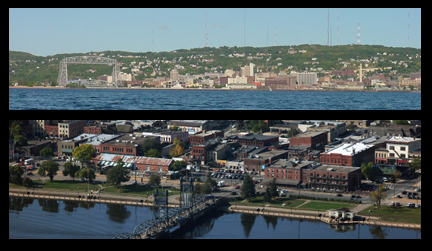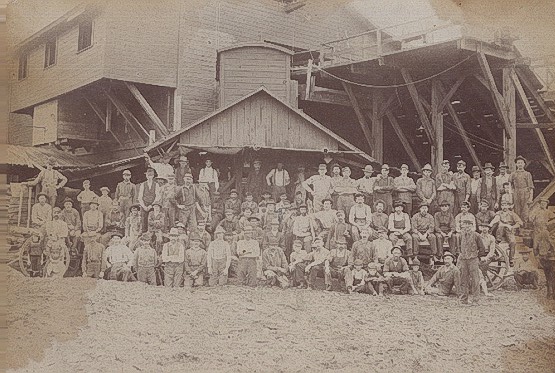Receive the Historical Messenger in your inbox once every two weeks by signing up for our mailing list!
|
This issue: Contents
Tuesday, December 1st, 2015
Editor’s NoteWell, winter has finally reared its snowy head here in Minnesota! Didn’t you miss scraping ice off your windshield every morning?! I hope you had a fantastic Thanksgiving this past week! Maybe you even decided to brave the hordes of Black Friday shoppers! If you’ve still got some names on your holiday shopping list, be sure to check out our first News Story to get all the info on our Annual Holiday Book Sale! If you keep scrolling, we’ve got another mystery item for today’s “What Is This Thing?!” eagerly waiting your best guesses. In today’s Old News, we’ll take a look at two Minnesotan cities that really have quite a bit in common. And yes, the WCHS museums may be closed for the season, but don’t worry – you can still get your fill of Washington County history on our website! Did you know that our website has an Online Exhibit section? Explore our virtual tours through history and enjoy a sample section on the history of Oak Park Heights as our Featured Article! Want to learn more about the history of Washington County? “Like” WCHS on Facebook and follow us on Twitter! Sean Pallas Historical Messenger editor and Warden’s House Site Manager WCHS NewsAnnual Holiday Book Sale and Open House
Avoid the overly-pushy department store crowds and instead have a truly unique holiday shopping experience while meeting local authors, sipping coffee generously donated by Starbucks, and enjoying live holiday songs provided by Mary Taylor Allen’s local student musicians at our annual book sale. Not to mention that some of our most popular titles will be up to 50% off their normal price! Our books and DVDs cover a wide variety topics such the histories of various Washington County communities, notable historical figures from the area, Minnesotans in the Civil War, and of course, the Old Stillwater Prison and the infamous Younger Brothers. The featured author this season is former teacher and principal in District #834, Bernie Anderson. Anderson completed a book titled, The Magic That Was Stonebridge: Reflections from an Era of Teacher Empowerment, a book detailing the unique structure of Stonebridge Elementary School in Stillwater. Anderson writes that “positive transformations were woven into best practices on a daily basis” at Stonebridge. From 1967 to 2001 he worked at Forest Hills, Marine on St. Croix, Oak Park, Rutherford and Stonebridge. Others authors include Robert and Nancy Goodman (In Their Own Words, The Last Rafter, and more), Gloria VanDemmeltraadt (Memories of Lake Elmo, Darkness in Paradise) Bill Schrankler (Shadows of Time: Minnesota’s Surviving Railroad Depots), Frederick L. Johnson (Suburban Dawn, Sea Wing Disaster), Ken Martens (The Perilous St. Croix River Valley Frontier), and Brent Peterson (Stillwater: The Next Generation) will be on hand to chat about their newest works and sign copies of their books. This is the perfect personalized gift for the lover of history in your life! The Warden’s House Museum is located at 602 Main Street N. in Stillwater, MN. Please contact Sean Pallas at 651-439-5956 or spallas.wchs@gmail.com for more information on this event or to arrange a tour of the museum. What is This Thing?!
Last week’s What Is This Thing?! is definitely an example of the more embarassing side of Washington County history. Several people supposed this was used as a type of horse or other type of animal mouth bit…and that’s close, but it was actually used on people. The Old Stillwater Prison had some pretty harsh rules. If inmates were acting up, this device was used as a form of punishment. The leather portion would be strapped around the back of their head while the metal section would be inserted into the prisoner’s mouth. Then the guards would have been able to lead the thoroughly dehumanized inmate around by the face. Thank you to everyone who participated in last week’s challenge! For this week, we’ll tackle something a bit more on the lighter side of our collection… As you see in the photo, this is a collapsible version of something. The important elements of this item are all on display, including the pins in the foreground. Can you identify the WCHS artifact photographed above? Can you guess its use? If you’d care to venture an answer, you can send an email to me at spallas.wchs@gmail.com, tweet @WCHSMN, or post your guess on our Facebook page. Good luck! Old NewsMinnesotan ConnectionsWhile attending the Univeristy of Minnesota: Duluth I absolutely fell in love with that northern city. Where else in the middle of the country are you in an ocean port?
After spending a fair time in both locales, I’ve noticed a number of interesting parallels between Duluth and Stillwater. Just to name a few: they’re both built on a hill, htey’re both just across the water from Wisconsin, and obviously, they both feature iconic historic lift bridges. When comparing their histories you’ll see that both enjoyed moments of being major industrial and commerical centers. At the same time the Zenith City was projected to outgrow Chicago; Stillwater’s lumber industry was literally building the nation. But, in another parallel, eventually the Iron Range dried up and Minnesota’s old growth forests were depleted. Today, these former industrial titans have been forced to adapt by shifted their focus to tourism. Thousands flock to Duluth every year to tour the elegant Glensheen Mansion and Stillwater’s historic downtown district is packed with “day-cationers” every summer. Through highlighting the history of their former glory days, both cities have discovered ways to flourish in the modern world. The following article discusses a trip to Duluth by notable founding fathers of Stillwater including her first mayor – John McKusick. Stillwater and Duluth – Stillwater Republican – December 1, 1870 Messrs. McKusick, McCluer, Proctor and others, who took a pleasure trip to Duluth last week, returned on Saturday, much delighted with their journey, and impressed with the sights they had seen. They report that all talk in Duluth is of Stillwater and the approaching Railroad connection with this city. They look upon Stillwater as destined to be, in the future, a more important point than St. Paul. Duluth, and the Superior Railroad company, are exceedingly anxious for a connection with the Tomah road via Stillwater, and will unite with us to bridge Lake St. Croix at this point, and make the connection directly east. And one at all familiar with the country can see at once that this would give Duluth a much shorter eastern and southern connection than any she can get through St. Paul, and a much more direct one that to rundown the Lake here and cross at Hudson. John McKusick says he never had any great ideas of Duluth until he had seen it and looked it over for himself. But he is now convinced that an immense city must arise somewhere about the head waters of Lake Superior – the probabilities are rather in favor of Duluth than of Superior City, Bayfield or any other point. They propose at Duluth to the wholesale trade and grain shipping of all this region, and in our opinion she can control both next season, if she and the Philadelphia parties interested in her growth will put in the required capital and energy. Stillwater and the country tributary are greatly interested in the growth of Duluth for a great metropolis there will give us advantages which could not accrue to us from any other source. If Duluth can control the commerce of the Northwest north of the line of central Iowa, or even north of the southern line of Minnesota, Stillwater must become the gathering point of a large trade which might otherwise center at points below us. The interests of Duluth and Stillwater are closely interwoven, and both cities will work together for mutual welfare. Featured ArticleOak Park Heightsfrom the WCHS Community Histories Online Exhibit
Early settlers were David Cover, a river pilot who came to Oak Park in the 1840s and dealt in logs and lumber, and John Parker, who relocated from St. Croix Falls in 1850. Early development centered around Mill Street, which led to the river and the milling townsites just to the south. In the 1880s, a sawmill was constructed along Oak Park’s riverfront, along with a barrel-making company. About 1890 Jewish settlers Moritz and Bertha Bergstein settled in Oak Park. They operated a waste materials yard with a warehouse and “shoddy” mill, where waste fabric was recycled into stuffing for mattresses. The rubble stone mill building and warehouse still stand but are in the path of the new bridge construction, and are slated to be moved. Oak Park’s nearness to Stillwater and the main road to St. Paul encouraged a number of well-to-do residents to build impressive homes on the bluff overlooking Lake St. Croix. Still, only a few hundred people called it home in 1910. By 1914 the new Minnesota State Prison had been built next to Oak Park, bringing new economic activity to the area, but there was little new construction in the 1920s and 1930s. Oak Park, today known as Oak Park Heights, has been considerably changed by recent development. Highway 36 was cut through in the 1930s, dividing the community. Improvements to Highways 36 and 95 and construction of the Allen S. King generating plant and its power lines in the 1970s had considerable impact on the residential community. In the late 1990s, a portion of the original townsite including many of the mid-19th-century bluff homes was razed in preparation for a new river bridge. When Highway 36 was extended to Stillwater in the 1930s, automobile tourists flocked to the river valley. One old vestige of this era is the Club Tara Hideaway. This log cabin style roadhouse, built in 1932 as Lynch’s Chicken Shack and still in business as a restaurant today, is typical of the establishments that sprang up to cater to motorists. Another artifact of the automobile culture is the limestone wayside overlook on Lookout Trail, constructed in 1938s by the National Youth Administration. Both are on the original alignment of Highway 36. Little commercial or residential growth occurred in Oak Park Heights until 1960 when construction started on the St. Croix Mall. Oak Park Heights has become highly commercial, at least along the Highway 36 corridor, which features dozens of businesses and eating places. Considerable development has taken place on the south side of the highway, extending past Highway 5. Krueger’s Christmas Tree Farm has been replaced with big box stores, restaurants, apartments, and two large malls. Stillwater Motors, the Post Office distribution center, the Stillwater Area High School, and Boutwells Landing Senior Living Center are also in Oak Park Heights. The Minnesota Correctional Facility–Oak Park Heights on Orleans Street opened in 1982 as a maximum security prison. The community has numerous parks, including Brekke Park, which overlooks the large Bayport Wildlife Management Area. Although sometimes overshadowed by its neighbors, this growing community of more than 4,000 residents is still thriving. Oak Park was replatted in 1938 as the village of Oak Park Heights and incorporated in 1959. Its growth has sped up, adding more than 1,000 residents since 1990, to about 4,795 in 2014. |
Events
More information: WCHS Events >>> Preserve the Past, Share in the Future!Become a member of the Washington County Historical Society! Membership is one way that you can help support the Washington County Historical Society. Your membership helps us collect, preserve, and disseminate the history of Washington County for county residents and visitors in the belief that a historical perspective enhances our understanding of community and sense of place. Benefits of membership:
The Washington County Historical Society has depended on membership ever since it was formed in 1934. Please show your support for the organization by becoming a member today. More: WCHS Membership >>> Mission StatementWashington County Historical Society collects, preserves, and disseminates the history of the county and state of Minnesota.
|
|||||



 Likewise, I have now been the site manager of the Warden’s House in Stillwater through four seasons and have been completely swept up in the history of this town.
Likewise, I have now been the site manager of the Warden’s House in Stillwater through four seasons and have been completely swept up in the history of this town.